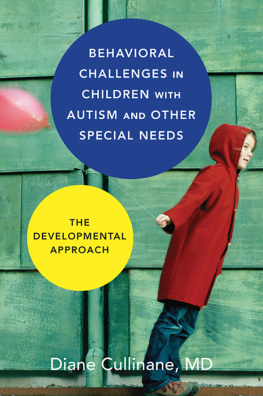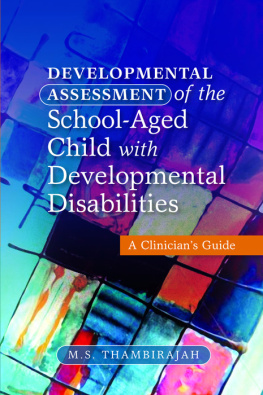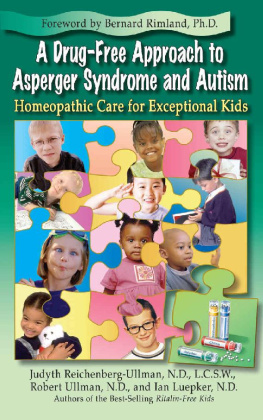

Ben, a husky 11-year-old nonverbal boy with autism, does not want to leave the building. He wants to continue his routine of counting all the doors. When urged to move toward the exit, he falls to the ground and resists all attempts to get him up. To make matters worse, he is screeching and blocking the path in a public place. This behavior happens almost every time he must leave a building. What can anyone do?
Parents, clinicians, and teachers face a multitude of similar situations, big and small, every day. There is no shortage of adviceoften conflictingcoming from family, neighbors, friends, strangers, teachers, and a host of clinicians. An adult might demand, Get up now, or you cant have your iPad, or try to entice with, If you get up now, you can have ice cream, or simply give in: Okay, lets go count the doors. Often, the adult in charge feels embarrassed, discouraged, and even desperate. Many of us would admit that we really dont know what to do.
The behavior of children with autism or other developmental disabilities can be perplexing. Both parents and professionals may seek help in understanding and managing challenging behaviors. Professionals in the behavioral or mental health field, such as those providing child and family counseling, address behaviors as a direct focus of their work. Those in related fields whose focus is not directly related to behavior, such as speech and language therapy, occupational or physical therapy, music therapy, or education must respond to challenging behaviors that occur in their therapy sessions or classrooms simply to enable them to work on other goals. Both parents and professionals face these challenges, and the best success occurs when they collaborate to help children conquer their difficulties.
This book presents a developmental framework and practical steps for understanding and addressing behavioral challenges in children of all ages, especially those with autism or other developmental challenges. The developmental approach is a way of understanding and responding to behaviors in the context of a childs functional emotional developmental capacities, individual differences, and pattern of affective interactions in relationships. This approach is founded on universal principles and applied to fit the unique children and adults who are interacting together.
The History of the Developmental Approach
The developmental framework for understanding childhood behavior is the outgrowth of a rich history of the study of children and learning. Over the years, philosophers, psychologists, educators, and physicians have pondered the ideal way to parent, to educate, and to help children overcome immature, impulsive, self-centered behaviors and become productive citizens of the world. Theorists have debated the relative importance of experience versus the natural unfolding of biological maturational processes to account for volitional behavior, language, and complex thinking.
One early area of study was learning theory, in which behaviorists such as Ivan Pavlov (1927/2012), John B. Watson (1925), and B. F. Skinner (1953) focused on the power of environmental stimuli to shape behavior. They posited that human behavior could be understood as predictable responses to environmental signals.
The developmental psychologist, Jean Piaget (1952), viewed cognitive development as being internally motivated. He chronicled his observations of childrens interactions with objects, and showed how children actively sought out novelty and learned from their own curiosity and initiative. Lev Vygotsky (1978) and Jerome Bruner (1990) also viewed children as active learners and emphasized the role of social interaction in cognitive development. Lawrence Kohlberg (1981, 1984) studied moral development in children using Piagetian constructs with further consideration of social interaction.
A separate field of study focused on psychodynamic development. Although Sigmund Freud (1923/1960) did not study children directly, he was one of the first to recognize the importance of childhood emotional experiences for the creation of the inner psychic life of adults, both conscious and unconscious. Anna Freud (1965), Erik Erikson (1963), and Margaret Mahler (1975) advanced the study of psychological development, particularly in regard to a childs relationship with his or her parents.
The field of humanistic psychology introduced a new perspective, valuing individuality, the development of the self as a comprehensive whole, creativity, and relationships. Major contributors to this area of thought were Carl Rogers (1961) and Abraham Maslow (1962/2014). Virginia Mae Axline (1947) built on these ideas and described play therapy for children using nondirective approaches.
Others extended insights into child development through their study of infants. Among these, John Bowlby (1951, 1969/1999), Mary Ainsworth (Ainsworth, Bell, & Stayton, 1974), T. Berry Brazelton (Brazelton & Nugent, 1973/1995), Alan Fogel (1993), Daniel Stern (1985/2000), Donald Winnicott (1971/2005), and others recognized the remarkable capacities of infants and young children to form emotional attachments and engage in complex social interactions with caregivers.
Two broad areas of study, cognitive-developmental psychology and affective psychodynamic psychology, were largely separate fields until relatively recently. Building on the values of humanistic psychology, Stanley I. Greenspan (1979) synthesized psychodynamic theory and cognitive developmental learning models into a comprehensive developmental framework. Greenspan was the first to put forward the idea that emotional or affective experience in social interactions paves the way for all learning, including cognition and language. This understanding creates a major paradigm shift in the approach to treatment of children with developmental challenges.
The DIR Approach and the Role of Emotions in Development
Greenspans insight was to recognize that emotion and reason are inextricably intertwined. Dr. Greenspans (1979) seminal work, Intelligence and Adaptation, offers an integrated model of child development combining Piagetian cognitive stages and the Freudian psychoanalytic theoretical framework. This comprehensive model, now known as DIR and DIRFloortime, incorporates functional emotional developmental milestones (D) with each childs unique biological differences (I) and the patterns of affective interaction within key relationships (R).
The DIR model describes the integration of emotional experience and learning as predictable and consistent stages or milestones. The six milestones build from a foundation of shared attention, intimacy, and trust, to two-way gestural interaction, to shared problem solving, and then to higher levels of symbolic emotional ideas and logical thinking. These functional-emotional developmental milestones incorporate all the traditional domains of development, including movement, communication, social skills, and cognition. Greenspans novel revelation is the primacy of emotional experiences and interactions in propelling development forward, even to higher capacities of logical and abstract thinking and communicating. Among a host of applications, this model has become the basis of developmentally based intervention for children with autism and other neurodevelopmental disorders. Infancy and Early Childhood (Greenspan, 1992) contains an in-depth description of the model for work in early childhood development. Developmentally Based Psychotherapy (Greenspan, 1997) provides guidance on the use of the DIR model in psychotherapy for mental health disorders.
Next page









